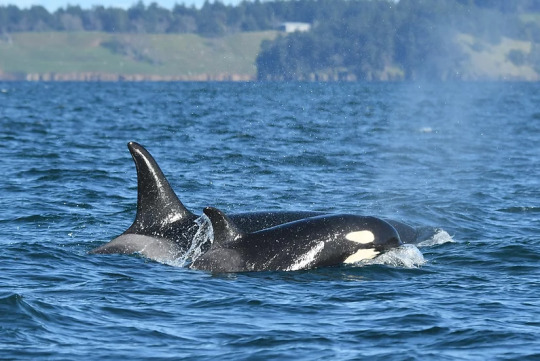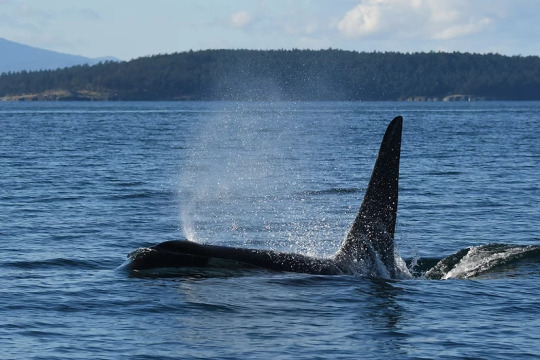#J42 Echo
Explore tagged Tumblr posts
Note
are there any whale news!
yeah actually! Remember how I was telling you about the new southern resident j60 and how scientists aren’t exactly sure who his mom is? Well, the plot thickens.
So J60 was seen for the first time with J40 Suttles, who is an adult female who is overdue for a first calf, so it makes sense for it to be hers, right? Well after that, J60 kept being seen with a different female, J16 Slick, with Suttles nowhere in sight.
Slick was first sighted as a calf in 1972, so she is 50+ years old. Orcas are actually one of the few animals to undergo menopause (alongside humans and a few other species of whales. No other primates!! just us and the whales) and females stop reproducing in their early 40s, just like humans. So it’s almost downright impossible for J60 to be Slick’s calf. Is Slick babysitting for Suttles? Maybe, but babysitting behavior tends to happen among family members, especially when a calf is so young, and Slick and Suttles aren’t closely related.
So currently, the theory is that J60 is actually the son of one of Slick‘s daughters, either J36 Alki or J42 Echo. Alki’s had a calf before but Echo hasn’t so if it’s hers, she might need extra help.
As for what Suttles was doing with J60, we’ll never really know, but it is a known phenomenon that young female killer whales will sometimes calfnap another whale’s baby when their maternal instincts get confused, or to practice when they have their own calf. It’s even been observed happening across species (remember the crazy beef orcas and pilot whales have I’ve talked about. orcas will sometimes kidnap pilot whale calves). So that’s probably what happened here.
Tldr; christmas whale baby has some weird ass family drama
3 notes
·
View notes
Text
November 16, 2021: J Pod- Haro Strait
J31 Tsuchi and J56 Tofino

J27 Blackberry


J42 Echo

J22 Oreo

J41 Eclipse and J58 Crescent


J26 Mike


J39 Mako

Photo Credit to the Center for Whale Research Encounter #87 - Nov 16, 2021
#J31#J31 Tsuchi#J56#J56 Tofino#J27#J27 Blackberry#J42#J42 Echo#J22#J22 Oreo#J41#J41 Eclipse#J58#J58 Crescent#J26#J26 Mike#J39#J39 Mako#southern resident orcas#southern resident killer whales#southern resident community#SRKW#J Pod
76 notes
·
View notes
Photo

J42, also known as Echo
Echo is Slick’s fourth child and youngest living offspring. Echo’s younger sister, Scarlet (J50), sadly failed to thrive from birth and was presumed dead in September 2018. Echo’s other two remaining siblings are named Mike (J26) and Alki (J36). The whale museum describes her as ‘spunky’!
#orca#orcinus orca#killer whale#srkw#southern resident killer whale#j pod#j42#i tried to draw her but i cannot draw and so she turned out looking way too wide#unwilling to do her dirty like that#failed to thrive is the most netrual language i can put j50s death in#horribly disappointed in the response to j50s suffering tbh#waited too long on an intervetion there#sorry you lost a sibling echo
40 notes
·
View notes
Text

InkTober nr.24: J42 Echo, a female born in 2007. After the death of her younger sister J50 Scarlet, Echo is once again the youngest member of this family, which consists of her mother J16 Slick, older brother J26 Mike and older sister J36 Alki.
The Southern Residents are starving to death before our eyes. We have to take action now; breach the dams, ban salmon fishing and stop the pipelines! Check out pnwprotectors.com, damsense.org and whaleresearch.com for more information on how you can help. This is up to us!
61 notes
·
View notes
Video
J50 and her pod by NOAA Fisheries West Coast Via Flickr: J50 is still keeping up with her pod, Aug. 9, 2018. (Photo: Katy Foster/NOAA Fisheries, permit #18786)
J42 Echo, J16 Slick, and J36 Alki are all sticking close to J50 Scarlet.
#orca#killer whale#srkw#j pod#j16s#j16#j50#j42#j36#southern residents#southern resident killer whales#cetaceans#salish sea
59 notes
·
View notes
Photo

Happy Mother's Day to all the moms out there! We hope you get good and spoiled!⠀ Photo: J16 "Slick" with her daughters J42 "Echo" and J50 "Scarlet" by @taslishaw ⠀ #whaletales #orca #whales #killerwhales #SRKW #JPod #motherdays #moms #matriline #whalewatching #getonaboat #happymothersday #mothersday2018🌼
#srkw#mothersday2018🌼#getonaboat#motherdays#killerwhales#moms#whalewatching#jpod#matriline#whaletales#happymothersday#orca#whales
24 notes
·
View notes
Photo

Recent photo of J42 Echo by Deanna Brett. We should all be concerned about this.
100 notes
·
View notes
Photo

Bad News As of 19 September, another SRKW (J52 - a two and a half year old male) is deceased, presumably from malnutrition. All of the SRKW observed this summer appear lean, and they appear to us to be skinny and small compared to Bigg’s Transient killer whales in the Salish Sea that have abundant prey resources (seals and other marine ). - Sonic was the first offspring of J36 "Alki." He is survived by his uncle J26 "Mike" and aunts J42 "Echo" and J50 "Scarlet," who was born only two months before J52. J52 was reported emaciated Sept. 13 from unmanned hexacopter photographs by Holly Fearnbach, Drs. John Durban (NOAA) and Lance Barrett-Lennard (Coastal Ocean Research Institute). - In the early years of our study, the average calving interval (live birth) for sexually mature females was calculated to be 5.2 years, with a 3 year interval observed for some females. The abort/neonate mortality was estimated at 42% of conceptions. The average calving interval (live birth) is now 9+ years, and the abort/neonate mortality is estimated to be 75% or more. - All indications (population number, foraging spread, days of occurrence in the Salish Sea, body condition, and live birth rate/neonate survival) are pointing toward a predator population that is prey limited and non-viable. We know that the SRKW population-sustaining prey species is Chinook salmon, but resource managers hope that they find something else to survive. If something isn’t done to enhance the SRKW prey availability almost immediately (it takes a few years for a Chinook salmon to mature and reproduce, and it takes about twelve years for a female SRKW to mature and reproduce), extinction is inevitable within decades to a century with current predator/prey trajectories. - PC: Center for Whale Research Caption: Orca Network Via @wild.orcas
0 notes
Link
Port Angeles
With blue skies above and the Olympics in full view behind us we started our journey knowing that our resident orcas had returned this morning and were heading to the San Juan Islands. It was a long ride to get there but both J Pod and L Pod were spread out fishing hard for salmon. We watched as two adult males one of whom was J27 Blackberry along with a J Pod female..we spent a serious amount of time enjoying the orcas as they traveled and searched for food seeing small groups off in the distance also. We eventually turned to find some more animals as we headed back across the straits and found two more orcas from L Pod. One was a female named Balena and the second one L92 Cruiser an adult male. They were traveling together and we had some beautiful close passes from them. It was a joy to see. Knowing we had a long trip back to the dock we had to say our goodbyes as they continued on towards the San Juan wishing them good fishing and full bellies.
Anacortes
Morning Tour:
It was a notable low tide today as we left Cap Sante Marina. First up was a stop at Bird Rocks where we found dozens of harbor seals hauled out, oyster catchers, and two mature bald eagles feeding on something obscured amongst the rocks. The amount of exposed intertidal habitat this morning was incredible, and offered fantastic looks at a variety of seaweeds and marine invertebrates including pisaster starfish, chiton, and anemones. We cruised past south Lopez near Blind Island where we saw a mature bald eagle, black tailed deer, and a bald eagle's nest. We continued west, almost up to Lime Kiln, where we met up with some members of L pod before making a quick turn to meet up with J pod near Victoria as they made their way towards the west coast of San Juan. We cruised with various members of the pod, including J47, J26, and J16 as they spread out across Haro Strait.
Afternoon Tour:
We cruised by Bird Rocks where we found some dozing harbor seals, a flock of oyster catchers, and some juvenile gulls. Next we cruised along the southern coast of Lopez near Blind Island where we spotted a harbor seal mom and pup hauled out, and two mature bald eagles calling to each other near an eagle nest. We continued west and met back up with J pod as they cruised north along the west coast of San Juan. The pod was pretty spread out so we stayed with a group of the younger members of the pod (including J42 Echo and J50 Scarlet) as they played with each other at the surface. Tail slaps, spy hops, swimming into and on top of each other, splashing all around, it was quite a sight to see. Next we broke off to cruise with J26 (Mike) as he slowly made his way up the Strait. We got an unexpected up close inspection by Mike when he swam right along our side, visibly looking up at us from beneath the water, an absolutely surreal encounter. On our route home we cruised along the south coast of Spiden Island where we saw sika deer, fallow deer, and mouflon sheep! We also saw a beautiful juvenile bald eagle perched in the treetops. An incredible end to a wildlife-filled evening.
0 notes
Note
It seems I made a mistake with my post on J42 echo. I forgot to source the photo when I was typing it up. The owner is Deanna Brett. Very sorry about that!
Thank you. @prairieorca also provided a link to the source image if others are curious for that as well.
0 notes
Link
The two orca close-ups are that of J42 Echo. Is it the lighting or does she look thin?
0 notes
Text
January 26, 2022: J Pod- Harney Channel









J26 Mike

J16 Slick, J36 Alki, J42 Echo, and J26 Mike

J38 Cookie and J45 Se-Yi-Chn

Photo Credit to the Center for Whale Research Encounter #9 - Jan 26, 2022
#J26#J26 Mike#J16#J16 Slick#J36#J36 Alki#J42#J42 Echo#J38#J38 Cookie#J45#J45 Se-Yi-Chn#southern resident orcas#southern resident community#southern resident killer whales#srkw#J pod
25 notes
·
View notes
Photo

J-42, Echo!
2 notes
·
View notes
Text

And today’s InkTober: nr. 6 J36 Alki, my current adoption orca! Born in 1999 to mum J16 Slick, Alki has an older brother, J26 Mike and a younger sister, J42 Echo. Three other siblings have passed away; J33 Keet, an unnamed calf J48 and most recently, Alki’s younger sister J50 Scarlet.
The Southern Residents are starving to death before our eyes. We have to take action now; breach the dams, ban salmon fishing and stop the pipelines! Check out pnwprotectors.com, damsense.org and whaleresearch.com for more information on how you can help. This is up to us!
35 notes
·
View notes
Note
Why isn’t anyone talking about K 25 and K 36?
They’re not at the stage of peanut head yet and could recover on their own like J42 Echo did. But in reality, the media doesn’t care now that J35 has dropped her calf. J50 was a baby and it looked good to try and save her but these two are adults and honestly, people seem to care more about J pod since they’re the most “resident” although no one’s talking about J49 either. I really wish people would care about the SRKWs as a whole and not just a select few.
21 notes
·
View notes
Photo

All three “Jabies” playing together just outside of Vancouver! To read this story (and more!), follow the link in our bio⠀ Photo: J50 and J52 with J42 “Echo” by @gary_j27⠀ #whaletales #jabies #killerwhale #orca #whales #exploreBC #yvr #vancouverisawesome #vancity #salishsea #getonaboat #whalewatching #storytelling
#getonaboat#killerwhale#whaletales#salishsea#storytelling#explorebc#yvr#jabies#orca#whalewatching#vancity#vancouverisawesome#whales
18 notes
·
View notes